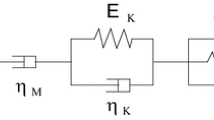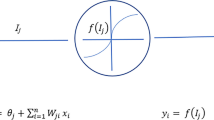Abstract
Xigeda formation is a type of hundred-meter-thick lacustrine sediments of being prone to triggering landslides along the trunk channel and tributaries of the upper Yangtze River in China. The Yonglang landslide located near Yonglang Town of Dechang County in Sichuan Province of China, which was a typical Xigeda formation landslide, was stabilized by anti-slide piles. Loading tests on a loading-test pile were conducted to measure the displacements and moments. The uncertainty of the tested geomechanical parameters of the Yonglang landslide over certain ranges would be problematic during the evaluation of the landslide. Thus, uniform design was introduced in the experimental design, and by which, numerical analyses of the loading-test pile were performed using Fast Lagrangian Analysis of Continua (FLAC3D) to acquire a database of the geomechanical parameters of the Yonglang landslide and the corresponding displacements of the loading-test pile. A three-layer back-propagation neural network was established and trained with the database, and then tested and verified for its accuracy and reliability in numerical simulations. Displacement back analysis was conducted by substituting the displacements of the loading-test pile to the well-trained three-layer back-propagation neural network so as to identify the geomechanical parameters of the Yonglang landslide. The neural-network-based displacement back analysis method with the proposed methodology is verified to be accurate and reliable for the identification of the uncertain geomechanical parameters of landslides.
Similar content being viewed by others
References
Anandarajah A, Agarwal D (1991) Computer-aided calibration of a soil plasticity model. International Journal for Numerical and Analytical Methods in Geomechanics 15(12): 835–856. https://doi.org/10.1002/nag.1610151202
Arai K, Ohta H, Kojima K (1984) Estimation of soil parameters based on monitored movement of subsoil under consolidation. Soils and Foundations 24(4): 95–108. https://doi.org/10.3208/sandf1972.24.4_95
Cundall PA (1976) Explicit finite difference methods in geomechanics. In Numerical Methods in Engineering, Proceedings of the International Conference on Numerical Methods in Geomechanics, Blacksburg, Virginia, USA 1: 132–150
Das SK (2013) Artificial neural networks in geotechnical engineering: modeling and application issues. Chapter 10, Metaheuristics in Water, Geotechnical and Transport Engineering, Editors X Yang, AH Gandomi, S Talatahari, AH Alavi, Elsevier, London, ISBN: 978-0-12-398296-4 pp. 231–270. https://doi.org/10.1016/B978-0-12-398296-4.00010-6
Das SK, Basudhar PK (2008) Prediction of residual friction angle of clays using artificial neural network. Engineering Geology 100(3–4):142–145. https://doi.org/10.1016/j.enggeo.2008.03.001
Das SK, Sivakugan N (2010) Discussion of Intelligent computing for modeling axial capacity of pile foundations. Canadian Geotechnical Journal 47(8):928–930. https://doi.org/10.1139/T10-048
Deng JH, Lee CF (2001) Displacement back analysis for a steep slope at the Three Gorges Project site. International Journal of Rock Mechanics and Mining Sciences 38(2): 259–268. https://doi.org/10.1016/S1365-1609(00)00077-0
Fang KT (1980) The uniform design: application of numbertheoretic methods in experimental design. Acta Mathematicae Applicatae Sinica 3(4):363–372
Fang KT, Li RZ (2006) Uniform design for computer experiments and its optimal properties. International Journal of Materials and Product Technology 25(1–3): 198–210. https://doi.org/10.1504/IJMPT.2006.008282
Fang KT, Lin DKJ, Winker P, Zhang Y (2000) Unifrom design: theory and applications. Technometrics 42(3): 237–248. https://doi.org/10.2307/1271079
Fausett LV (1994) Fundamentals of neural networks: architectures, algorithms and applications. Prentice-Hall, Inc., USA.
Feng XT, Zhang ZQ, Sheng Q (2000) Estimating mechanical rock mass parameters relating to the Three Gorges Project permanent shiplock using an intelligent displacement back analysis method. International Journal of Rock Mechanics and Mining Sciences 37(7): 1039–1054. https://doi.org/10.1016/S1365-1609(00)00035-6
Feng XT, Zhao HB, Li SJ (2004) A new displacement back analysis to identify mechanical geo-material parameters based on hybrid intelligent methodology. International Journal for Numerical and Analytical Methods in Geomechanics 28(11): 1141–1165. https://doi.org/10.1002/nag.381
Gioda G, Locatelli L (1999) Back analysis of the measurements performed during the excavation of a shallow tunnel in sand. Numerical and Analytical Methods in Geomechanics, 23(13): 1407–1425. https://doi.org/10.1002/(SICI)1096-9853(199911)23:13<1407::AID-NAG934>3.0.CO;2-Q
Hagan MT, Menha, MB (1994). Training feedforward networks with the Marquardt algorithm. IEEE Transactions on Neural Network 5(6): 989–993. https://doi.org/10.1109/72.329697
Huang RQ, Li WL (2011) Formation, distribution and risk control of landslides in China. Journal of Rock Mechanics and Geotechnical Engineering 3(2): 97–116. https://doi.org/10.3724/SP.J.1235.2011.00097
Kavanagh KT, Clough RW (1971) Finite element application in the characterization of elastic solids. International Journal of Solids and Structures 7(1): 11–23. https://doi.org/10.1016/0020-7683(71)90015-1
Kong P, Granger DE, Wu FY, Caffee MW, Wang YJ, Zhao XT, Zheng Y (2009) Cosmogenic nuclide burial ages and provenance of the Xigeda paleo-lake: Implications for evolution of the Middle Yangtze River. Earth and Planetary Science Letters 278(1–2): 131–141. https://doi.org/10.1016/j.epsl.2008.12.003
Marquardt DW (1963) An algorithm for least-squares estimation of nonlinear parameters. Journal of the Society for Industrial and Applied Mathematics 11(2): 431–441. https://doi.org/10.1137/0111030
Marti J, Cundall P (1982) Mixed discretization procedure for accurate solution of plasticity problems. International Journal for Numerical and Analytical Methods in Geomechanics 6(1): 129–139. https://doi.org/10.1002/nag.1610060109
Matlab (2011) Matrix Laboratory: Version R2011b. MathWorks Inc., USA
Moreira N, Miranda T, Pinheiro M, Fernandes P, Dias D, Costa L, Sena-Cruz J (2013) Back analysis of geomechanical parameters in underground works using an evolution strategy algorithm. Tunnelling and Underground Space Technology 33: 143–158. https://doi.org/10.1016/j.tust.2012.08.011
Najjar YM, Basheer IA, Naouss WA (1996) On the identification of compaction characteristics by neuronets. Computers and Geotechnics 18(3): 167–187. https://doi.org/10.1016/0266-352X(95)00030-E
Nakamura S, Wakai A, Umemura J, Sugimoto H, Takeshi T (2014) Earthquake-induced landslides: Distribution, motion and mechanisms. Soils and Foundations 54(4): 544–559. https://doi.org/10.1016/j.sandf.2014.06.001
Oreste P (2005) Back-analysis techniques for the improvement of the understanding of rock in underground constructions. Tunnelling and Underground Space Technology 20(1): 7–21. https://doi.org/10.1016/j.tust.2004.04.002
Pichler B, Lackner R, Mang HA (2003) Back analysis of model parameters in geotechnical engineering by means of soft computing. International Journal for Numerical Methods in Engineering 57(14): 1943–1978. https://doi.org/10.1002/nme.740
Rumelhart DE, Hinton GE, Williams RJ (1986) Learning representations by back-propagating errors. Nature 323: 533–536. https://doi.org/10.1038/323533a0
Sakurai S (1997) Lessons learned from field measurements in tunneling. Tunnling and Underground Space Technology 12(4): 453–460. https://doi.org/10.1016/S0886-7798(98)00004-2
Sakurai S, Takeuchi K (1983) Back analysis of measured displacements of tunnels. Rock Mechanics and Rock Engineering 16(3): 173–180. https://doi.org/10.1007/BF01033278
Shahin MA (2010) Intelligent computing for modeling axial capacity of pile foundations. Canadian Geotechnical Journal 47(2): 230–243. https://doi.org/10.1139/T09-094
Shahin MA, Maier HR, Jaksa MB (2002) Predicting settlement of shallow foundations using neural network. Journal of Geotechnical and Geoenvironmental Engineering 128(9): 785–793. https://doi.org/10.1061/(ASCE)1090-0241(2002)128:9(785)
Shirangi MG, Emerick AA (2016) An improved TSVD-based Levenberg–Marquardt algorithm for history matching and comparison with Gauss-Newton. Journal of Petroleum Science and Engineering 143: 258–271. https://doi.org/10.1016/j.petrol.2016.02.026
Swoboda G, Ichikawa Y, Dong QX, Zaki M (1999) Back analysis of large geotechnical models. International Journal for Numerical and Analytical Methods in Geomechanics 23(13): 1455–1472. https://doi.org/10.1002/(SICI)1096-9853(199911)23:13<1455::AID-NAG33>3.0.CO;2-C
Wang Y, Fang KT (1981) A note on uniform distribution and experimental design. Chinese Science Bulletin 26(6): 485–489. https://doi.org/10.1142/9789812701190_0035
Wang ZL, Li YC, Shen RF (2007) Correction of soil parameters in calculation of embankment settlement using a BP network back-analysis model. Engineering Geology 91(2–4): 168–177. https://doi.org/10.1016/j.enggeo.2007.01.007
Yang ZF, Lee CF, Wang SJ (2000) Three-dimensional backanalysis of displacement in exploration adits-principles and application. International of Rock Mechanics and Mining Sciences 37(3): 525–533. https://doi.org/10.1016/S1365-1609(99) 00079-9
Yang ZF, Wang ZY, Zhang LQ, Zhou RG, Xing NX (2001) Backanalysis of viscoelastic displacements in a soft rock road tunnel. International Journal of Rock Mechanics and Mining Sciences 38(3): 331–341. https://doi.org/10.1016/S1365-1609(00)000 81-2
Yu YZ, Zhang BY, Yuan HN (2007) An intelligent displacement back-analysis method for earth-rockfill dams. Computers and Geotechnics 34(6): 423–434. https://doi.org/10.1016/j.compgeo.2007.03.002
Zhang LQ, Yue ZQ, Yang ZF, Qi JX, Liu FC (2006) A displacement-based back-analysis method for rock mass modulus and horizontal in situ stress in tunneling-illustrated with a case study. Tunnelling and Underground Space Technology 21(6): 636–649. https://doi.org/10.1016/j.tust.2005.12.001
Zhao HB, Yin SD (2009) Geomechanical parameters identification by particle swarm optimization and support vector machine. Applied Mathematical Modelling 33(10): 3997–4012. https://doi.org/10.1016/j.apm.2009.01.011
Zhou YX, Wu XP (1994) Use of neural networks in the analysis and interpretation of site investigation data. Computers and Geotechnics 16(2): 105–122. https://doi.org/10.1016/0266-352X(94)90017-5
Acknowledgements
This work was supported by the “Light of West China” Program of Chinese Academy of Sciences (Grant No.Y6R2250250), the National Basic Research Program of China (973 Program, Grant No.2013CB733201), the One-Hundred Talents Program of Chinese Academy of Sciences (Lijun Su), the Key Research Program of Frontier Sciences, Chinese Academy of Sciences (Grant No.QYZDB-SSW-DQC010) and the Youth Fund of Institute of Mountain Hazards and Environment, Chinese Academy of Sciences (Grant No. Y6K2110110).
Author information
Authors and Affiliations
Corresponding author
Rights and permissions
About this article
Cite this article
Yu, Fw., Peng, Xz. & Su, Lj. A back-propagation neural-network-based displacement back analysis for the identification of the geomechanical parameters of the Yonglang landslide in China. J. Mt. Sci. 14, 1739–1750 (2017). https://doi.org/10.1007/s11629-016-4193-y
Received:
Revised:
Accepted:
Published:
Issue Date:
DOI: https://doi.org/10.1007/s11629-016-4193-y




